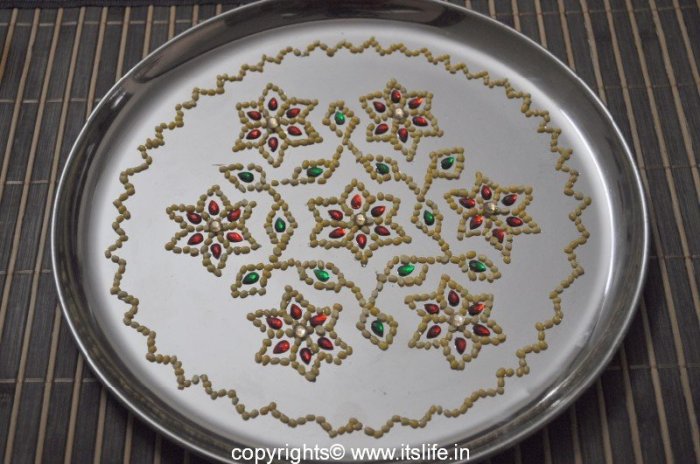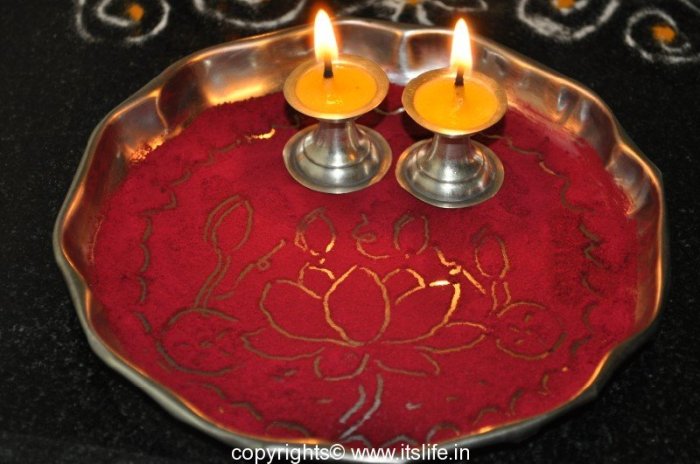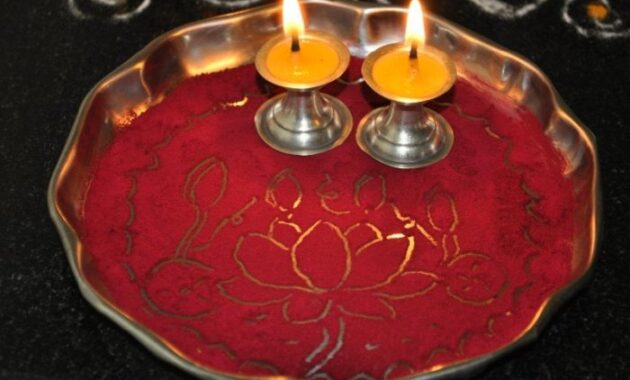What is Arathi Plate Decoration?
How to make arathi plate decoration – Arathi plate decoration is a traditional Indian art form that involves arranging and decorating a plate with various items for religious ceremonies or special occasions. The plate is usually used during the arathi ritual, where a lamp is lit and moved around in circular motions in front of a deity or an honored guest.
Tips for Arathi Plate Decoration
1. Choose a theme: Decide on a theme for your arathi plate decoration, whether it’s traditional, modern, floral, or festive.
2. Select a plate: Pick a plate that suits your theme and size preferences. It can be a simple metal plate, a decorative thali, or a colorful plastic plate.
3. Gather materials: Collect items like flowers, leaves, colored powders, diyas (lamps), incense sticks, and other decorative elements.
4. Plan the layout: Sketch out a rough idea of how you want to arrange the items on the plate before starting the decoration process.
5. Use colors wisely: Incorporate a color scheme that complements your theme and creates a visually appealing design.
What is Known About Arathi Plate Decoration?
Arathi plate decoration is a popular tradition in South Indian households, where it is considered an essential part of welcoming guests and honoring deities during religious ceremonies. The art form requires creativity, attention to detail, and a knack for harmoniously combining different elements on a single plate.
Exploring the realm of men’s fashion, one cannot overlook the significance of footwear. Among the plethora of options available, one stands out as a timeless classic – most stylish men’s dress shoes. These shoes exude sophistication and elegance, making them a staple in every man’s wardrobe. From sleek oxfords to stylish loafers, each pair tells a unique story of craftsmanship and style.
Solution for Arathi Plate Decoration

To create a stunning arathi plate decoration, follow these steps:
1. Start by placing a small diya (lamp) in the center of the plate as the focal point.
2. Surround the diya with fresh flowers, leaves, or petals to add color and fragrance to the arrangement.
3. Sprinkle colored powders or kumkum around the diya in intricate patterns to enhance the visual appeal.
4. Add incense sticks or aromatic herbs to create a pleasant aroma during the arathi ritual.
5. Complete the decoration by adding decorative elements like beads, sequins, or mirrors for an extra touch of glamour.
Detail Information on Arathi Plate Decoration: How To Make Arathi Plate Decoration
Arathi plate decoration can vary widely in style and complexity, depending on the occasion and personal preferences. Some common elements used in arathi plate decoration include:
– Fresh flowers: Roses, marigolds, jasmine, and lotus flowers are popular choices for adding color and fragrance to the plate.
– Leaves: Mango leaves, banana leaves, and palm leaves are often used to create a natural and rustic look.
When it comes to the world of men’s fashion, one cannot overlook the importance of footwear. Among the most essential items in a man’s wardrobe are his dress shoes. These shoes are not just for practical purposes but also serve as a statement of style and sophistication. If you are looking to elevate your look, consider investing in a pair of most stylish men’s dress shoes that exude elegance and class.
– Colored powders: Rangoli powders or kumkum are used to create intricate patterns and designs on the plate.
– Diyas: Small oil lamps or diyas are essential for the arathi ritual and can be decorated with beads or sequins for added flair.
How to Make Arathi Plate Decoration in Depth

To create a beautiful arathi plate decoration, follow these detailed steps:
1. Clean the plate: Start by cleaning the plate thoroughly to ensure a fresh and polished base for decoration.
2. Arrange the diya: Place a small diya in the center of the plate and fill it with oil or ghee for lighting during the arathi ritual.
3. Add flowers: Surround the diya with fresh flowers, either in a circular pattern or randomly scattered for a natural look.
4. Decorate with leaves: Place mango leaves or banana leaves around the flowers to create a lush and vibrant border.
5. Use colored powders: Sprinkle colored powders like rangoli or kumkum around the diya and flowers to enhance the visual appeal.
6. Add incense sticks: Place incense sticks in holders around the plate to create a fragrant atmosphere during the arathi ritual.
7. Enhance with decorative elements: Finally, add beads, sequins, mirrors, or other decorative elements to the plate to make it visually stunning and unique.
Conclusion
Arathi plate decoration is a beautiful and meaningful art form that adds a touch of tradition and elegance to religious ceremonies and special occasions. By following these tips and ideas, you can create a stunning arathi plate decoration that will impress your guests and honor the deities in a creative and thoughtful way.
FAQs, How to make arathi plate decoration
1. Can I use artificial flowers for arathi plate decoration?
Yes, you can use artificial flowers if fresh flowers are not available for your arathi plate decoration. Just make sure they are clean and in good condition.
2. How long does it take to make an arathi plate decoration?
The time it takes to make an arathi plate decoration can vary depending on the complexity of the design and the materials used. It can take anywhere from 30 minutes to a few hours to complete.
3. Can I customize the arathi plate decoration to suit a specific theme?
Yes, you can customize the arathi plate decoration to fit any theme or occasion by selecting appropriate colors, materials, and decorative elements that align with your desired aesthetic.
4. Are there any traditional symbols or motifs used in arathi plate decoration?
Yes, traditional symbols like om, swastika, lotus, and peacock motifs are commonly used in arathi plate decoration to convey auspiciousness, prosperity, and devotion.
5. Is arathi plate decoration only done for religious purposes?
While arathi plate decoration is often associated with religious rituals, it can also be used for festive occasions, weddings, and other celebrations to add a decorative touch to the festivities.







